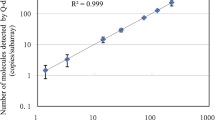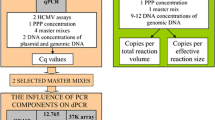Abstract
Analytical real-time PCR technology is a powerful tool for implementation of the GMO labeling regulations enforced in the EU. The quality of analytical measurement data obtained by quantitative real-time PCR depends on the correct use of calibrator and reference materials (RMs). For GMO methods of analysis, the choice of appropriate RMs is currently under debate. So far, genomic DNA solutions from certified reference materials (CRMs) are most often used as calibrators for GMO quantification by means of real-time PCR. However, due to some intrinsic features of these CRMs, errors may be expected in the estimations of DNA sequence quantities. In this paper, two new real-time PCR methods are presented for Roundup Ready soybean, in which two types of plasmid DNA fragments are used as calibrators. Single-target plasmids (STPs) diluted in a background of genomic DNA were used in the first method. Multiple-target plasmids (MTPs) containing both sequences in one molecule were used as calibrators for the second method. Both methods simultaneously detect a promoter 35S sequence as GMO-specific target and a lectin gene sequence as endogenous reference target in a duplex PCR. For the estimation of relative GMO percentages both “delta CT” and “standard curve” approaches are tested. Delta CT methods are based on direct comparison of measured CT values of both the GMO-specific target and the endogenous target. Standard curve methods measure absolute amounts of target copies or haploid genome equivalents. A duplex delta CT method with STP calibrators performed at least as well as a similar method with genomic DNA calibrators from commercial CRMs. Besides this, high quality results were obtained with a standard curve method using MTP calibrators. This paper demonstrates that plasmid DNA molecules containing either one or multiple target sequences form perfect alternative calibrators for GMO quantification and are especially suitable for duplex PCR reactions.

Similar content being viewed by others
References
Anklam E, Gadani F, Heinze P, Pijnenburg H, Van den Eede G (2002) Eur Food Res Technol 215:334–339
Bonfini L, Heinze P, Kay S, Van den Eede G (2002) Review of GMO detection and quantification techniques. IHCP, JRC, EC, EUR 20384 EN, p 67
Griffiths K, Partis L, Croan D, Wang N, Emslie K (2002) Review of technologies for detecting genetically modified materials in commodities and food. Department of Agriculture, Fisheries and Forestry, Australian Government Analytical Laboratories (AGAL), p 118
Holst-Jensen A, Ronning SB, Lovseth A, Berdal KG (2003) Anal Bioanal Chem 375:985–993
European Commission Regulation 1829/2003 Off J Eur Communities L 268/1; 18.10.2003
European Commission Regulation 258/97 Off J Eur Communities L 43; 14.2.1997
http://www.europa.eu.int, MEMO/02/160-REV, Brussels. Cited 4 Mar 2003
Walker R, Lumley I (1999) Trends Anal Chem 18:594–616
Pietsch K, Waiblinger HU (1999) In: Meuer S, Wittwer C, Nakagawara K (eds) Rapid cycle real-time PCR—methods and applications, preprint, p 7
Wurz A, Bluth A, Zeltz P, Pfeifer C, Willmund R (1999) Food Control 10:385–389
Alary R, Serin A, Maury D, Jouira HB, Sirven J-P, Gautier M-F, Joudrier P (2002) Food Control 13:235-244
Zeitler R, Pietsch K, Waiblinger HU (2002) Eur Food Res Technol 214:346–351
Dahinden I, Zimmermann A, Liniger M, Pauli U (2002) In: Reischl U, Wittwer C, Cockerill F (eds) Rapid cycle real-time PCR—methods and applications, microbiology and food analysis. Springer, Berlin Heidelberg New York, pp 251–258
Brodmann PD, Ilg EC, Berthoud H, Herrmann A (2002) J AOAC Int 85:646–653
Hübner P, Waiblinger H-U, Pietsch K (2001) J AOAC Int 84:1855–1864
Terzi V, Farrari B, Finocchiaro F, De Fonze N, Stanca AM, Lamacchia C, Napier J, Shewry AR, Faccioli P (2003) J Cereal Sci 37:157–163
Block A, Schwarz G (2003) Eur Food Res Technol 216:421–427
Vaïtilingom M, Pijnenburg H, Gendre F, Brignon P (1999) J Agric Food Chem 47:5261–5266
Berdal KG, Holst-Jensen A (2001) Eur Food Res Technol 213:432–438
Hernandez M, Pla M, Esteve T, Prat S, Puigdomenech P, Ferrando A (2003) Transgenic Res 12:179–189
Ronning SB, Vaïtilingom M, Berdal KG, Holst-Jensen A (2003) Eur Food Res Technol 216:347–354
Terry CF, Shanahan DJ, Ballam LD, Harris N, McDowell DG, Parkes HC (2002) J AOAC Int 85:938–944
Hird H, Powell J, Johnson M-L, Oehlschlager S (2003) J AOAC Int 86:66–71
Terry CF, Harris N (2001) Eur Food Res Technol 213:425–431
Pardigol A, Guillet S, Pöpping B (2003) Eur Food Res Technol 216:412–420
Holck A, Vaïtilingom M, Didierjean L, Rudi K (2002) Eur Food Res Technol 214:449–453
Taverniers I, Windels P, Van Bockstaele E, De Loose M (2001) Eur Food Res Technol 213:417–424
Kuribara H, Shindo Y, Matsuoka T, Takubo K, Futo S, Aoki N, Hirao T, Akiyama H, Goda Y, Toyoda M, Hino A (2002) J AOAC Int 85:1077–1089
Trapmann S, Catalani P, Conneely P, Corbisier P, Gancberg D, Hannes E, Le Guern L, Kramer GN, Prokisch J, Robouch P, Schimmel H, Zeleny R, Pauwels J, Van den Eede G, Weighardt F, Mazzara M, Anklam E (2002) EUR 19573, European Commission
Shindo Y, Kuribara H, Matsuoka T, Futo S, Sawada C, Shono J, Akiyama H, Goda Y, Toyoda M, Hino A (2002) J AOAC Int 85:1119–1126
Windels P, Theuns I, Dendauw J, Depicker A, Van Bockstaele E, De Loose M (1999) Med Fac Landbouww Univ Gent 64:459–462
Windels P, Taverniers I, Depicker A, Van Bockstaele E, De Loose M (2001) Eur Food Res Technol 213:107–112
Puumalainen J, Paoletti C, Bertheau Y, Bonner P, Broll H, Damant A, De Santis B, Holst-Jensen A, Laurensse E, Monsted Jorgensen M, Onori R, Stephensen Lübeck P, Taverniers I, Trapmann S, Van den Eede G (2003) Definition of minimum performance requirements for analytical methods of GMO testing, ENGL WG Validation, Version 1.7.2003
Burns M, Shanahan D, Valdivia H, Harris N (2003) Eur Food Res Technol 216:428–433
Anklam E, Neumann, DA (2002) J AOAC Int 85:754–756
Van den Eede G, Kay S, Anklam E (2002) J AOAC Int 85:757–761
Theuns I, Windels P, De Buck S, Depicker A, Van Bockstaele E, De Loose M (2002) Euphytica 123:75–84
Taverniers et al. (in preparation)
Acknowledgements
We wish to thank Cindy Merckaert and Friedle Vanhee for excellent technical assistance, and Didier Allaer from Diagenode for providing the GM Soybean (RRS) Detection Plasmid Set. This work was financially supported by DWTC and O&O from the Belgian Government and by the EU.
Author information
Authors and Affiliations
Corresponding author
Electronic Supplementary Material
Rights and permissions
About this article
Cite this article
Taverniers, I., Van Bockstaele, E. & De Loose, M. Cloned plasmid DNA fragments as calibrators for controlling GMOs: different real-time duplex quantitative PCR methods. Anal Bioanal Chem 378, 1198–1207 (2004). https://doi.org/10.1007/s00216-003-2372-5
Received:
Revised:
Accepted:
Published:
Issue Date:
DOI: https://doi.org/10.1007/s00216-003-2372-5




